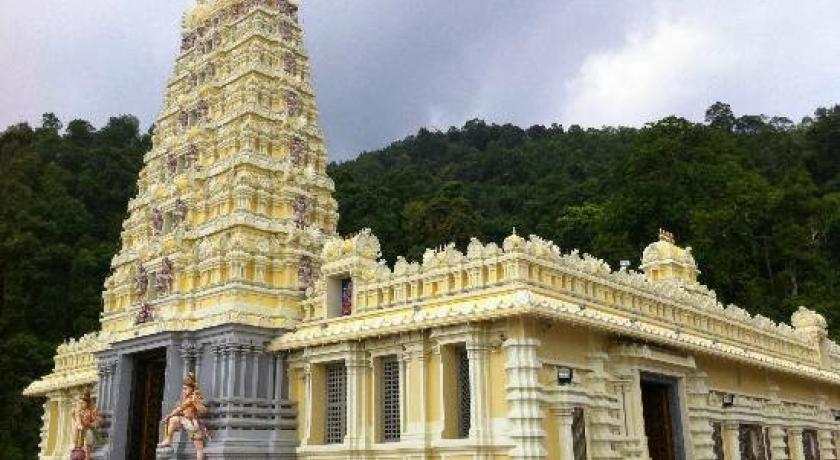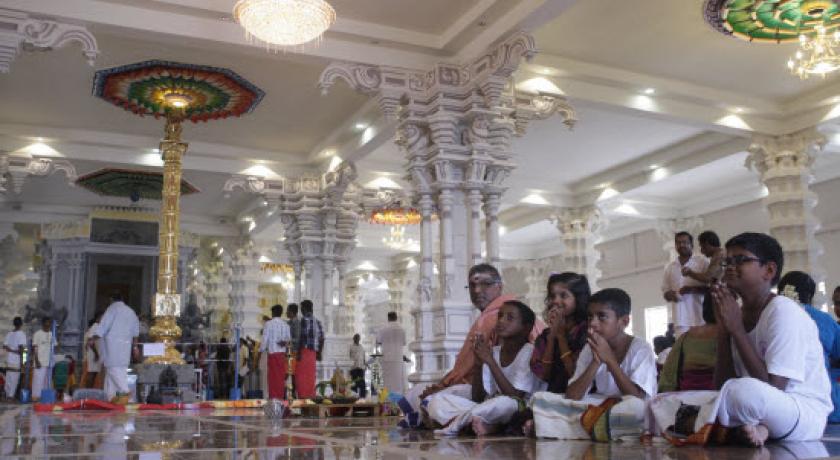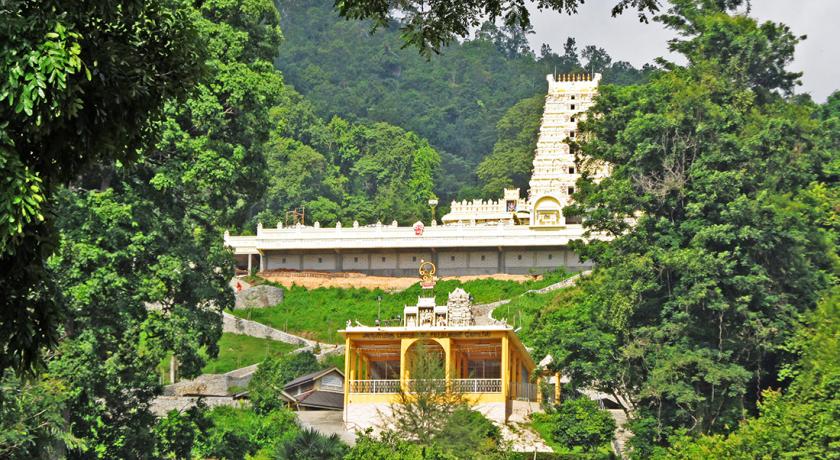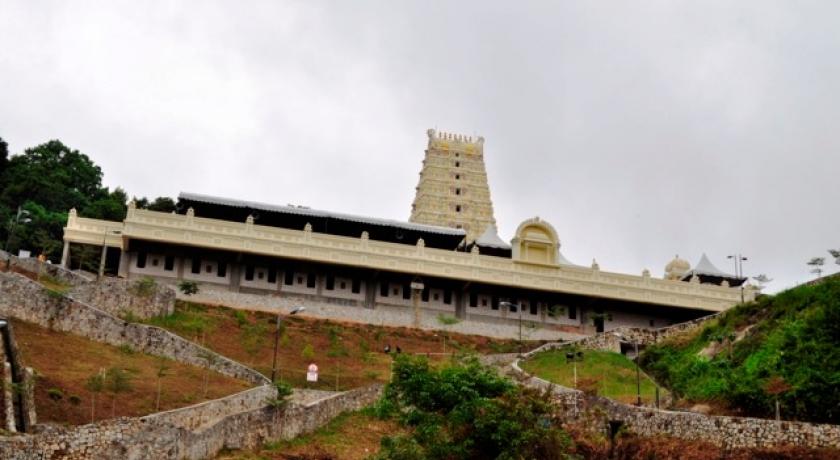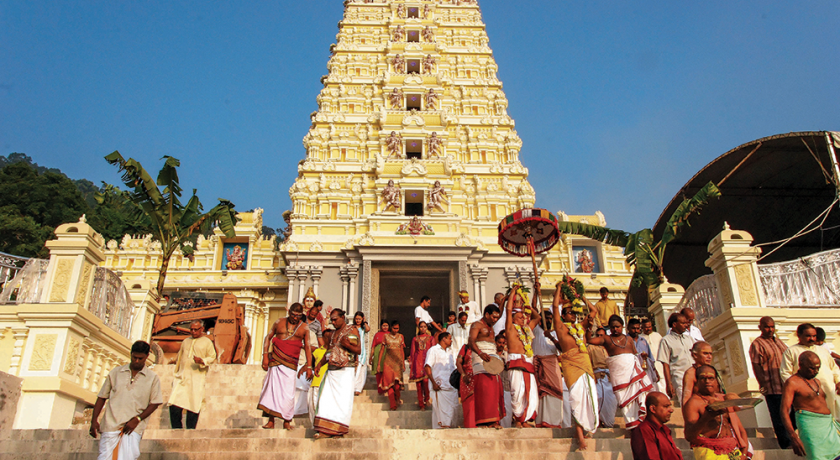Description
The Balathandayuthapani Temple, officially the Arulmigu Balathandayuthapani Kovil, better known as the Waterfall Hill Temple or "Thaneer Malai" (Tamil: Ó«ģÓ«░Ó»üÓ«│Ó»ŹÓ««Ó«┐Ó«ĢÓ»ü Ó«¬Ó«ŠÓ«▓Ó«żÓ«ŻÓ»ŹÓ«¤Ó«ŠÓ«»Ó»üÓ«żÓ«¬Ó«ŠÓ«ŻÓ«┐ Ó«ĢÓ»ŗÓ«»Ó«┐Ó«▓Ó»Ź) by locals, is considered one of the oldest temples in George Town, Penang. The main deity of this temple is Murugan. Visitors need to climb 513 stairs to reach the temple. It is the focal point of the Hindu festival of Thaipusam in Malaysia, after the Batu Caves. The hilltop temple, with its seven-storey 21.6m-tall gopuram (main tower), has been touted as the largest Lord Murugan temple outside India.
Daily Poojas
Darshan (meaning open to the public) hours are from 6 am to 8.30 pm.
The temple priests perform the puja (rituals) during festivals and on a daily basis. Abishegam or Thirumanjanam is anointment of the idol with oils, sandalwood paste, milk, unguents and the like and then bathing it with water in an act of ritual purification. The most prominent abishegams are conducted at the ceremonies to mark the hours of the day. These are four in number - the Kaala Santhi, early in the morning, the Ucchik─ülam, in the afternoon, the S─üyaratchai, in the evening and the Ardha J─ümam, at night, immediately prior to the temple being closed for the day.
Each ritual comprises four steps: abishegam (sacred bath), alangaram (decoration), naivethanam (food offering) and deepa aradanai (waving of lamps) all the deities. After the abishegam, it is the practice to dress the idols of the deities, in an act called alangaram, in one of several guises. The worship is held with religious instructions in the Vedas (Sanskrit sacred texts), Thirumurai (Tamil sacred texts) and Thiruppugazh (Tamil religious songs dedicated to Murugan) read by priests. These hours are marked by the tolling of the bell of the temple amidst music with nadaswaram (pipe instrument) and thavil (percussion instrument).
Devotees are ale to perform archanai by the priest thereafter.
- Abishegam (6 am)
- Kaala Santhi (7.30 am)
- Abishegam (11.45 am)
- Utchikkalam Pooja (12 pm)
- Abishegam (5 am)
- S─üyaratchai (6 pm)
- Abishegam (8.15 am)
- Ardha J─ümam (8.30 pm)
- Please note that on festivals and special occasions, Abishegam and Poojas start earlier than the scheduled time
History
According to popular belief, a sadhu (holy man) chose a spot close to the waterfalls for a shrine dedicated to Murugan. The place was called thanner malai, meaning water hill, and the deity itself was known as Thannermalaian, or "he who resides by the waterfall".
By the early 1800s the shrine seems to have been the focus of the Thaipusam celebration, a festival dedicated to Lord Murugan. British records and local newspapers mention Hindu devotees' celebration of the festival. In 1850 with the increase of the local population, the British authorities decided to develop the area into a reservoir. They decided that the waterfall area and the immediate catchment area had to be protected. At the same time they did not want to upset the sentiments of the Hindu population. Therefore, they alienated an eleven-acre hillside property for the location of a proper temple.
The Balathandayuthapani temple has undergone several major renovations. This is in keeping with the requirements of the Hindu religious tenets, that renovations be done for every mamangam, or 12-year cycle.
Over the years, as the number of devotees and worshippers increased, the Hindu Endowments Board found that the hilltop temple could no longer accommodate the numbers. This is especially true in the past decade, with more and more visitors converging on the temple, particularly during the Thaipusam celebration.
The grand consecration ceremony (Kumbabishegam) of the newly completed Arulmigu Balathandayuthapani temple was held on 29 June 2012. Built at a cost of 10 million ringgit, this temple is said to be the largest
Festival
Thaipusam
The ceremonial worship of Hindu's celebrated deity, Lord Muruga will begin with a silver chariot procession led by kavadis adorned with peacock features. The procession begins from Little India (6am) to the Nattukottai Chettiar Temple (ends at midnight).
Along the procession routes, coconuts are smashed onto the ground to fulfill sacred vows. The best place to catch the coconut smashing spectacle is on Jalan Dato Keramat, in front of Penang Times Square. Standby for the procession from 12noon onwards.
Religiously performed on Thaipusam Day, devotees will have their bodies pierced with hooks and spears as an act of penance. The piercing ceremony of the kavadi bearers will take place at the Sri Muthu Mariamman Temple on Lorong Kulit (beside Rapid Penang office) from 3am onwards. The uphill journey to the new Arulmigu Balathandayuthapani Temple (Waterfall Hilltop Temple) will begin right after. The best time to view the kavadis is from 3pm onwards. The final and bigger kavadi will climb up to the temple at 9.30pm.
Other devotees will also fulfill their vows by carrying Paal Kudam (milk pots) up to the Waterfall Hilltop Temple. The journey begins from Sri Muthu Mariamman Temple or the Shree Muniswarar Temple (at the junction of Jalan Utama, Jalan Kebun Bunga and Jalan Gottlieb).
For free refreshments and vegetarian food, visit one of the 130 festively decorated Thaneer Panthals (make shift stalls) along the pilgrimage route. More stalls are placed along Jalan Utama to Jalan Air Terjun (Waterfall Road).
The Silver Chariot of Lord Muruga makes a return trip from the Nattukottai Chettiar Temple (6pm) to the Kovil Veedu temple house on Lebuh Penang via a different route. The chariot is expected to reach at dawn, on the next day accompanied by the coconut smashing ritual and offerings of fruits, flowers and incense on a Thaambalam (big silver plate).
Golden Chariot
A RM3mil golden chariot hit the streets on the eve of Thaipusam on 8 February 2017. The 1.6-tonne golden chariot measuring 4.3m-high and 4m-wide will feature two golden horses in the front with several statues adorning the kalasam (tower). The chariot bearing Lord Muruga’s vel (spear) will move on rubberised wheels pulled by devotees. The inner frame of the chariot was made in Karaikudi and shipped to Penang where it was assembled.
The golden chariot’s journey will be from the Arulmigu Sri Maha Mariamman Temple in Queen Street to the Arulmigu Sri Ganesha Temple in Jalan Kebun Bunga. The chariot would be placed at the Sri Ganesha Temple for two days, on Thaipusam eve and on Thaipusam day.
An 18-day pooja (special prayers) session will be conducted for The 0.9m-tall golden vel at Queen Street Maha Mariamman Temple. This depicts the story goes that the vel was created by Lord Shiva’s consort Parasakthi who is also Lord Murugan’s mother. Parasakthi appeared in 18 forms before merging into a single indestructible vel which was handed to Lord Murugan during the Poosa natchathiram on Pournami Day (full moon) in the month of Thai (January to February). After receiving a blessing from the Lord’s mother, the vel will be sent back to Lord Murugan on the golden chariot on Thaipusam eve.
The golden chariot successfully completed its first trial run for Thaipusam in on 2 February 2017 about two hours through George Town in the presence of a large throng of devotees seeing it for the first time. The chariot went 3 km along Jalan Kebun Bunga, Lorong Air Terjun, Jalan Tunku Abdul Rahman, Jalan Macalister, Jalan Residensi and Jalan Utama before returning to the temple.
Source https://en.wikipedia.org/wiki/Arulmigu_Balathandayuthapani_Temple,_Penang
Address
George Town,Penang
Maleisië
Lat: 5.433202744 - Lng: 100.296760559


